Conservation Agriculture Improves Long-term Yield and Soil Quality in Irrigated Maize-oats Rotation
Abstract
:1. Introduction
2. Materials and Methods
2.1. Study Area and Experiment
2.2. Soil Quality
2.3. Economic Analysis
2.4. Data Set and Statistical Analysis
3. Results
3.1. Yield
3.2. Production Costs
3.3. Soil Quality
4. Discussion
5. Conclusions
Supplementary Materials
Author Contributions
Funding
Acknowledgments
Conflicts of Interest
References
- Verhulst, N.; Govaerts, B.; Verachtert, E.; Mezzalama, M.; Wall, P.C.; Chocobar, A.; Deckers, J.; Sayre, K.D. Conservation agriculture, improving soil quality for sustainable production systems. In Advances in Soil Science: Food Security and Soil Quality; Lal, R., Stewart, B.A., Eds.; CRC Press: Boca Raton, FL, USA, 2010; pp. 137–208. [Google Scholar]
- Kassam, A.; Derpsch, R.; Friedrich, T. Global achievements in soil and water conservation: The case of Conservation Agriculture. Int. Soil Water Conserv. Res. 2014, 2, 5–13. [Google Scholar] [CrossRef] [Green Version]
- SEMARNAT Informe de la Situación del Medio Ambiente en México. Compendio de estadísticas ambientales. In Indicadores Clave, de Desempeño Ambiental y de Crecimiento Verde; Edición 2015; SEMARNAT: Mexico City, Mexico, 2016. [Google Scholar]
- Knowler, D.; Bradshaw, B. Farmers’ adoption of conservation agriculture: A review and synthesis of recent research. Food Policy 2007, 32, 25–48. [Google Scholar] [CrossRef]
- Kassam, A.; Friedrich, T.; Derpsch, R. Global spread of conservation agriculture. Int. J. Environ. Stud. 2018, 76, 29–51. [Google Scholar] [CrossRef]
- Pittelkow, C.M.; Liang, X.; Linquist, B.A.; Van Groenigen, K.J.; Lee, J.; Lundy, M.E.; Van Gestel, N.; Six, J.; Venterea, R.T.; Van Kessel, C. Productivity limits and potentials of the principles of conservation agriculture. Nature 2014, 517, 365–367. [Google Scholar] [CrossRef]
- Verhulst, N.; Kienle, F.; Sayre, K.D.; Deckers, J.; Raes, D.; Limon-Ortega, A.; Tijerina-Chavez, L.; Govaerts, B. Soil quality as affected by tillage-residue management in a wheat-maize irrigated bed planting system. Plant Soil. 2011, 340, 453–466. [Google Scholar] [CrossRef]
- Verhulst, N.; Carrillo-García, A.; Moeller, C.; Trethowan, R.; Sayre, K.D.; Govaerts, B. Conservation agriculture for wheat-based cropping systems under gravity irrigation: Increasing resilience through improved soil quality. Plant Soil. 2011, 340, 467–479. [Google Scholar] [CrossRef]
- Sidhu, H.S.; Jat, M.L.; Singh, Y.; Sidhu, R.K.; Gupta, N.; Singh, P.; Singh, P.; Jat, H.S.; Gerard, B. Sub-surface drip fertigation with conservation agriculture in a rice-wheat system: A breakthrough for addressing water and nitrogen use efficiency. Agric. Water Manag. 2019, 216, 273–283. [Google Scholar] [CrossRef]
- Verhulst, N.; Sayre, K.D.; Vargas, M.; Crossa, J.; Deckers, J.; Raes, D.; Govaerts, B. Wheat yield and tillage-straw management system×year interaction explained by climatic co-variables for an irrigated bed planting system in northwestern Mexico. Field Crops Res. 2011, 124, 347–356. [Google Scholar] [CrossRef]
- Govaerts, B.; Sayre, K.D.; Goudeseune, B.; De Corte, P.; Lichter, K.; Dendooven, L.; Deckers, J. Conservation agriculture as a sustainable option for the central Mexican highlands. Soil Tillage Res. 2009, 103, 222–230. [Google Scholar] [CrossRef]
- García, H.M.D.; Rivera, J.R.A.; Salazar, H.C. Tendencias de la mecanización agrícola en el estado de San Luis Potosí, México. Interciencia 2002, 27, 307–311. [Google Scholar]
- Bolaños Gonzalez, M.A.; Paz Pellat, F.; Cruz Gaistardo, C.O.; Argumedo Espinoza, J.A.; Romero Benitez, V.M.; de la Cruz Cabrera, J.C. Erosion map of Mexico soils and its possible implications for soil organic carbon pool. Terra Latinoam. 2016, 34, 271–288. [Google Scholar]
- SIAP Servicio de Información Agroalimentaria y Pesquera. Available online: http://infosiap.siap.gob.mx/gobmx/datosAbiertos.php (accessed on 28 April 2018).
- Sarabia Meléndez, I.F.; Cisneros Almazán, R.; Aceves De Alba, J.; Durán García, H.M.; Castro Larragoitia, J. Calidad del agua de riego en suelos agricolas y cultivos del valle de San Luis Potosi, Mexico. Rev. Int. Contam. Ambie. 2011, 27, 103–113. [Google Scholar]
- Martínez Gamiño, M.Á.; Jasso Chaverria, C.; Osuna Ceja, E.S.; Reyes Muro, L.; Huerta Díaz, J.; Figueroa Sandoval, B. Efecto del fertirriego y labranza de conservación en propiedades del suelo y el rendimiento de maíz. Rev. Mex. Cienc. Agríc. 2018, 5, 937. [Google Scholar]
- Gavlak, R.; Horneck, R.; Miller, R.O.; Kotuby-Amacher, J. Soil, Plant and Water Reference Methods for the Western Region, 2nd ed; WREP: Fairbanks, AK, USA, 2003; Volume 1. [Google Scholar]
- Olsen, S.R.; Cole, C.V.; Watanabe, F.; Dean, L. Estimation of Available Phosphorus in Soil by Extraction with Sodium Bicarbonate; USDA circular No. 939; USDA: Washington, DC, USA, 1954.
- Walkley, A.; Black, I.A. An examination of the Degtjareff method for determining soil organic matter, and a proposed modification of the chromic acid titration method. Soil Sci. 1934, 37, 29–38. [Google Scholar] [CrossRef]
- Etchevers, B.J.; Goijberg, G.; López, R.R.M.; Padilla, C.J.; Alvarado-López, J.; Hidalgo, M.C.; Cruz, H.M.L.; Guerrero, P.A.; Gutiérrez, B.; Miranda, C.E. Manual de Procedimientos Analíticos Para Análisis de Suelos y Plantas del Laboratorio de Fertilidad de Suelos. In Programa de Intercalibración de Análisis de Suelos y Plantas; COLPOS: Texcoco, Mexico, 2000; pp. 24–26. [Google Scholar]
- CIMMYT Soil Aggregate Stability by Wet Sieving: A practical Guide for comparing Crop Management Practices; CIMMYT: Texcoco, Mexico, 2013; pp. 1–4.
- CIMMYT Soil Aggregate Distribution by Dry Sieving: A Practical Guide for Comparing Crop Management Practices; CIMMYT: Texcoco, Mexico, 2013; pp. 1–7.
- Govaerts, B.; Sayre, K.D.; Deckers, J. A minimum data set for soil quality assessment of wheat and maize cropping in the highlands of Mexico. Soil Tillage Res. 2006, 87, 163–174. [Google Scholar] [CrossRef]
- Pittelkow, C.M.; Linquist, B.A.; Lundy, M.E.; Liang, X.; van Groenigen, K.J.; Lee, J.; van Gestel, N.; Six, J.; Venterea, R.T.; van Kessel, C. When does no-till yield more? A global meta-analysis. Field Crop. Res. 2015, 183, 156–168. [Google Scholar] [CrossRef] [Green Version]
- Jat, R.K.; Sapkota, T.B.; Singh, R.G.; Jat, M.L.; Kumar, M.; Gupta, R.K. Seven years of conservation agriculture in a rice-wheat rotation of Eastern Gangetic Plains of South Asia: Yield trends and economic profitability. Field Crops Res. 2014, 164, 199–210. [Google Scholar] [CrossRef]
- Martínez Gamiño, M.A.; Jasso Chaverría, C. Rotación maíz-avena forrajera con labranza de conservación en el altiplano de San Luis Potosí México. Terra Latinoam. 2005, 23, 257–263. [Google Scholar]
- Parihar, C.M.; Yadav, M.R.; Jat, S.L.; Singh, A.K.; Kumar, B.; Pooniya, V.; Pradhan, S.; Verma, R.K.; Jat, M.L.; Jat, R.K.; et al. Long-Term Conservation Agriculture and Intensified Cropping Systems: Effects on Growth, Yield, Water, and Energy-use Efficiency of Maize in Northwestern India. Pedosphere 2018, 28, 952–963. [Google Scholar] [CrossRef]
- Turmel, M.S.; Speratti, A.; Baudron, F.; Verhulst, N.; Govaerts, B. Crop residue management and soil health: A systems analysis. Agric. Syst. 2015, 134, 6–16. [Google Scholar] [CrossRef]
- Hellin, J.; Erenstein, O.; Beuchelt, T.; Camacho, C.; Flores, D. Maize stover use and sustainable crop production in mixed crop-livestock systems in Mexico. Field Crops Res. 2013, 153, 12–21. [Google Scholar] [CrossRef] [Green Version]
- Beuchelt, T.D.; Camacho Villa, C.T.; Göhring, L.; Hernández Rodríguez, V.M.; Hellin, J.; Sonder, K.; Erenstein, O. Social and income trade-offs of conservation agriculture practices on crop residue use in Mexico’s central highlands. Agric. Syst. 2015, 134, 61–75. [Google Scholar] [CrossRef]
- Follett, R.F.; Castellanos, J.Z.; Buenger, E.D. Carbon dynamics and sequestration in an irrigated Vertisol in Central Mexico. Soil Tillage Res. 2005, 83, 148–158. [Google Scholar] [CrossRef]
- Jat, H.S.; Datta, A.; Choudhary, M.; Yadav, A.K.; Choudhary, V.; Sharma, P.C.; Gathala, M.K.; Jat, M.L.; McDonald, A. Effects of tillage, crop establishment and diversification on soil organic carbon, aggregation, aggregate associated carbon and productivity in cereal systems of semi-arid Northwest India. Soil Tillage Res. 2019, 190, 128–138. [Google Scholar] [CrossRef]
- Pausch, J.; Kuzyakov, Y. Carbon input by roots into the soil: Quantification of rhizodeposition from root to ecosystem scale. Glob. Chang. Biol. 2018, 24, 1–12. [Google Scholar] [CrossRef]
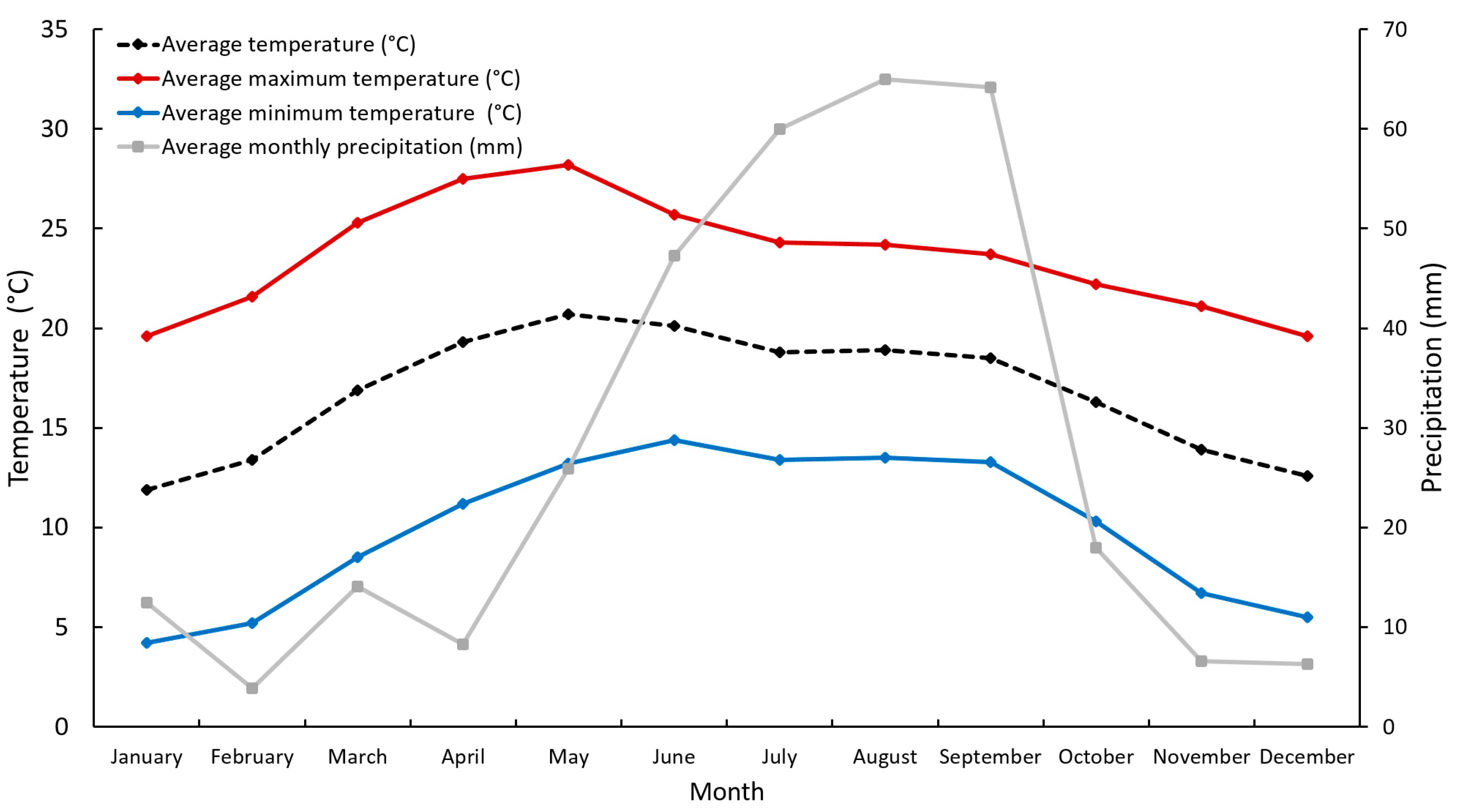
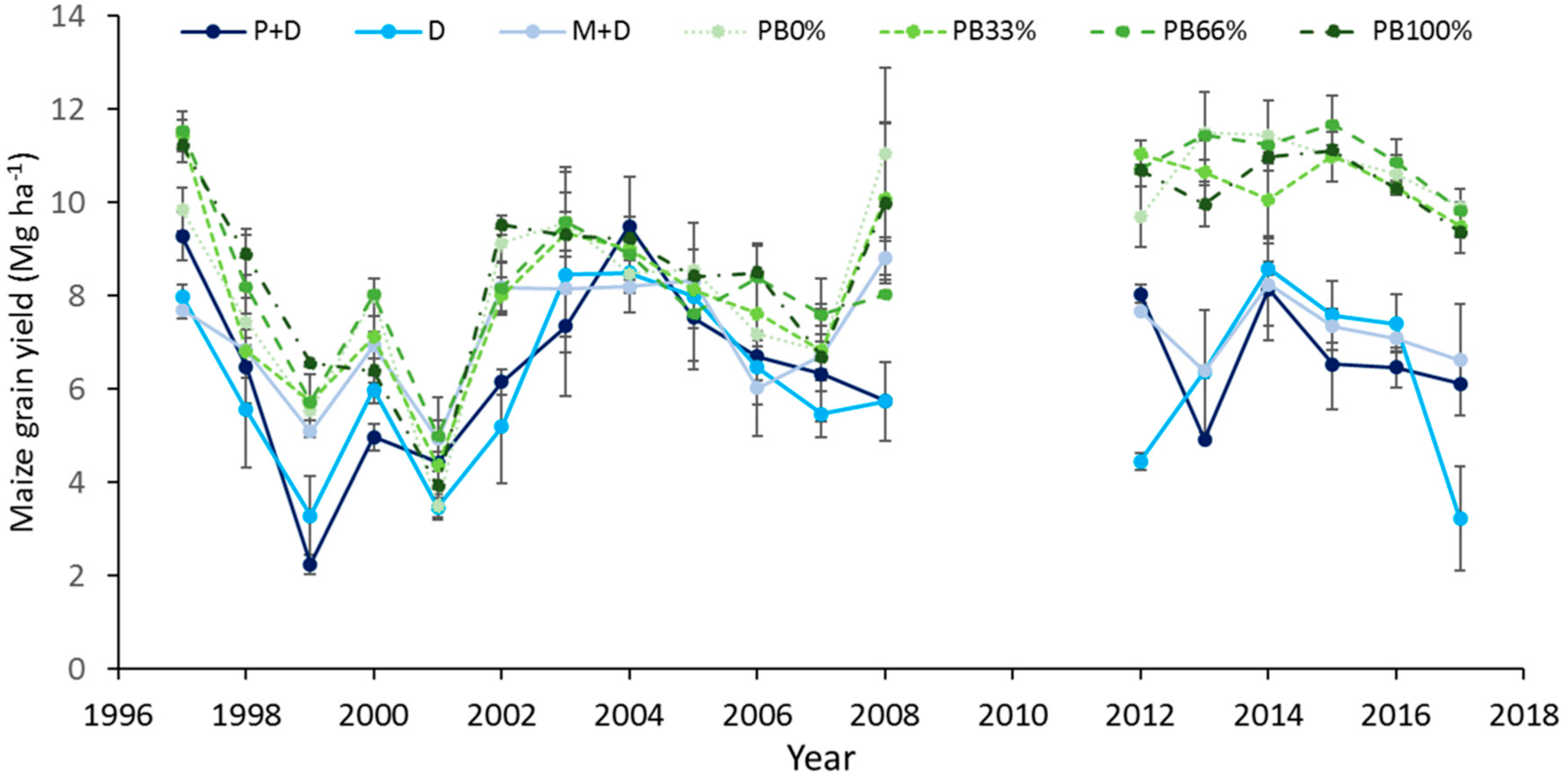
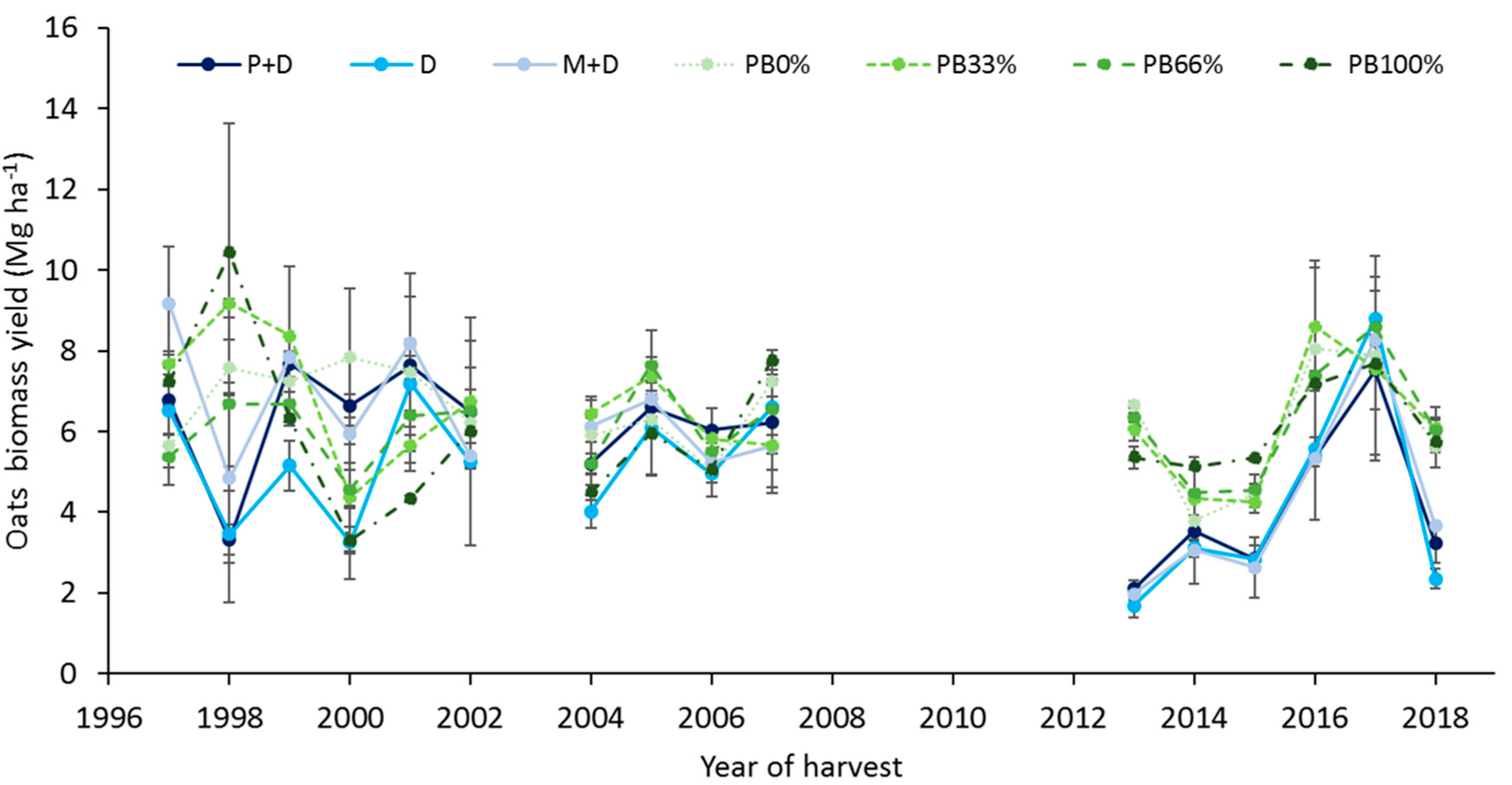
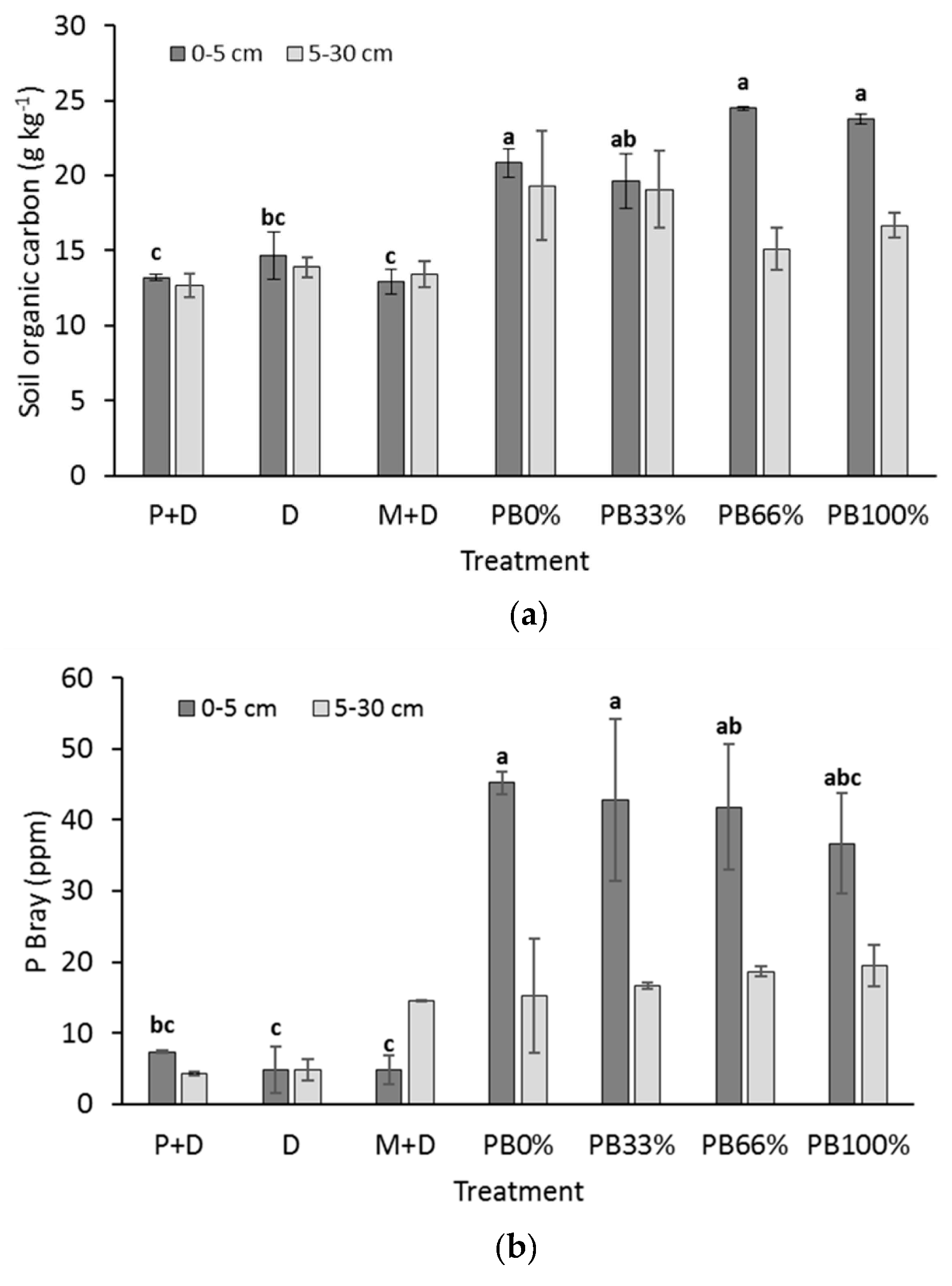
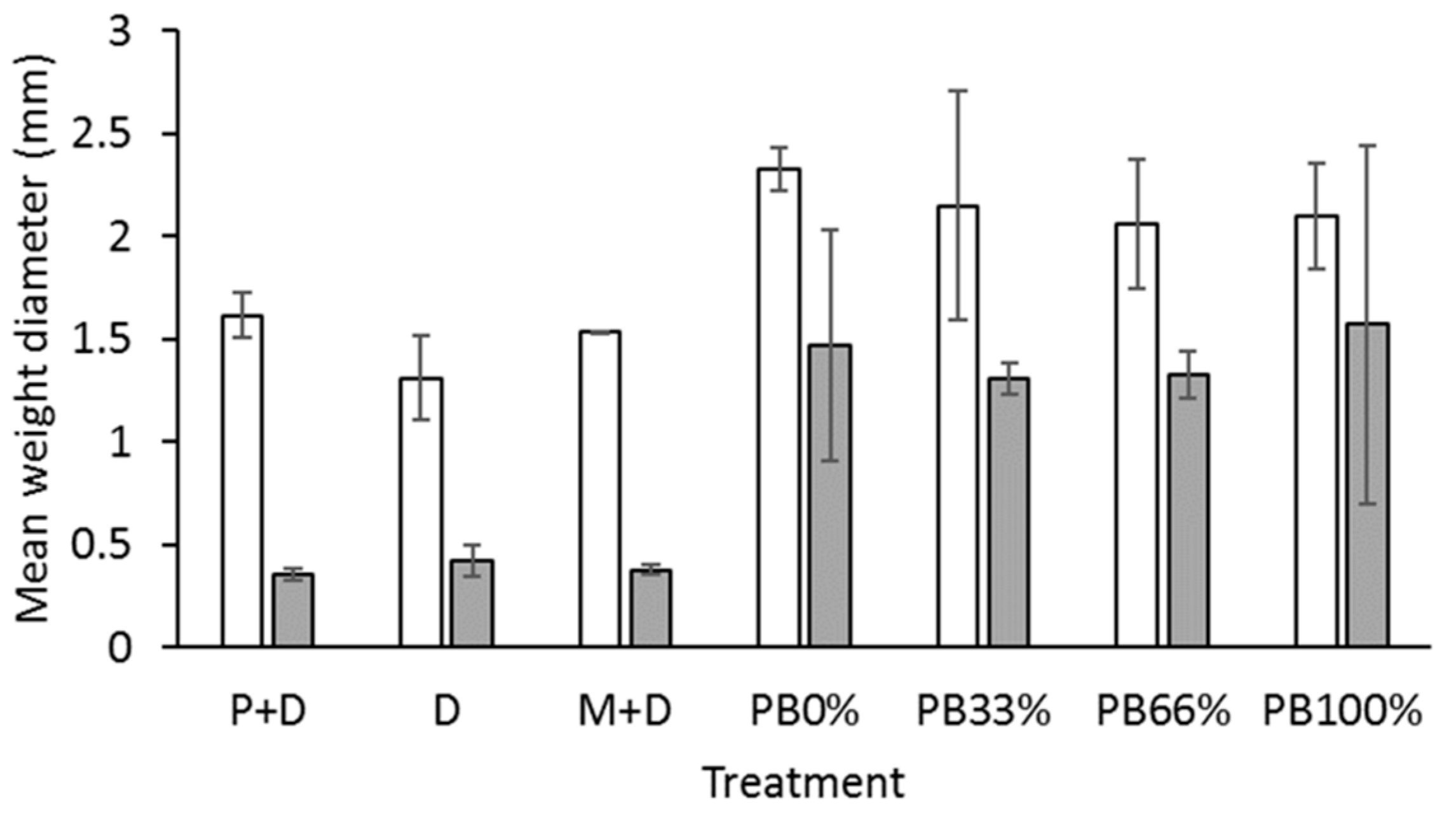
| No. | Abbreviation | Tillage Practice | Residue Management |
|---|---|---|---|
| 1 | P+D | Conventional: plowing and disking | Remove |
| 2 | D | Minimal: disking only | Remove |
| 3 | M+D | Reduced: multiplow and disking | Remove |
| 4 | PB0% | Permanent raised beds | Remove |
| 5 | PB33% | Permanent raised beds | 33% cover (1.3 Mg ha−1) |
| 6 | PB66% | Permanent raised beds | 66% cover (2.6 Mg ha−1) |
| 7 | PB100% | Permanent raised beds | 100% cover (4.0 Mg ha−1) |
| Treatment | Maize Yield (Mg ha−1) | |
|---|---|---|
| 1997–2008 | 2012–2017 | |
| P+D | 6.4 ± 1.9 bc | 6.7 ± 1.1 b |
| D | 6.2 ± 1.7 c | 6.3 ± 1.9 b |
| M+D | 7.2 ± 1.2 abc | 7.2 ± 0.6 b |
| PB0% | 7.9 ± 1.9 ab | 10.7 ± 0.7 a |
| PB33% | 7.9 ± 1.8 abc | 10.4 ± 0.5 a |
| PB66% | 8.1 ± 1.5 ab | 11.0 ± 0.6 a |
| PB100% | 8.2 ± 1.8 a | 10.4 ± 0.6 a |
| Treatment average | 7.4 ± 1.8 | 8.9 ± 2.2 |
| Treatment | 2014 | 2015 | 2016 | 2017 |
|---|---|---|---|---|
| P+D | 1.74 ± 0.01 | 1.78 ± 0.03 | 1.78 ± 0.03 | 1.81 ± 0.05 |
| D | 1.72 ± 0.03 | 1.88 ± 0.08 | 1.88 ± 0.08 | 0.75 ± 0.61 |
| M+D | 1.84 ± 0.09 | 1.83 ± 0.02 | 1.83 ± 0.02 | 1.80 ± 0.08 |
| PB0% | 2.41 ± 0.03 | 2.40 ± 0.00 | 2.40 ± 0.00 | 2.32 ± 0.03 |
| PB33% | 2.23 ± 0.02 | 2.45 ± 0.05 | 2.45 ± 0.05 | 2.32 ± 0.08 |
| PB66% | 2.41 ± 0.09 | 2.45 ± 0.05 | 2.45 ± 0.05 | 2.39 ± 0.09 |
| PB100% | 2.16 ± 0.03 | 2.45 ± 0.05 | 2.45 ± 0.05 | 2.29 ± 0.05 |
| Cost Category | P+D | D | M+D | PB0% | PB33% | PB66% | PB100% |
|---|---|---|---|---|---|---|---|
| Land preparation | 13 | 11 | 11 | 1 | 1 | 1 | 1 |
| Sowing | 11 | 12 | 12 | 12 | 12 | 12 | 12 |
| Fertilization | 22 | 22 | 22 | 23 | 23 | 23 | 23 |
| Weed and insect control | 11 | 11 | 11 | 17 | 17 | 17 | 17 |
| Irrigation | 29 | 30 | 29 | 31 | 31 | 31 | 31 |
| Harvest | 14 | 14 | 14 | 17 | 17 | 17 | 17 |
| Cycle | Category | P+D | D | M+D | PB0% | PB33% | PB66% | PB100% |
|---|---|---|---|---|---|---|---|---|
| 2015 | Soil preparation | $2880 | $2480 | $2480 | $240 | $240 | $240 | $240 |
| Sowing | $2600 | $2600 | $2600 | $2600 | $2600 | $2600 | $2600 | |
| Fertilization | $4089 | $4089 | $4089 | $4089 | $4089 | $4089 | $4089 | |
| Weed, disease and pest management | $2020 | $2020 | $2020 | $3060 | $3060 | $3060 | $3060 | |
| Irrigation | $6200 | $6200 | $6200 | $6200 | $6200 | $6200 | $6200 | |
| Harvest | $4000 | $4000 | $4000 | $4000 | $4000 | $4000 | $4000 | |
| Total production cost | $21,789 | $21,389 | $21,389 | $20,189 | $20,189 | $20,189 | $20,189 | |
| Total income | $29,392 | $34,087 | $33,073 | $49,370 | $49,488 | $52,519 | $50,014 | |
| Net income | $7603 | $12,698 | $11,685 | $29,181 | $29,299 | $32,331 | $29,825 | |
| 2016 | Soil preparation | $3600 | $3150 | $3150 | $450 | $450 | $450 | $450 |
| Sowing | $2750 | $2750 | $2750 | $2750 | $2750 | $2750 | $2750 | |
| Fertilization | $6800 | $6800 | $6800 | $6800 | $6800 | $6800 | $6800 | |
| Weed, disease and pest management | $2020 | $2020 | $2020 | $2870 | $2870 | $2870 | $2870 | |
| Irrigation | $9100 | $9100 | $9100 | $9100 | $9100 | $9100 | $9100 | |
| Harvest | $2400 | $2400 | $2400 | $3600 | $3600 | $3600 | $3600 | |
| Total production cost | $26,670 | $26,220 | $26,220 | $25,570 | $25,570 | $25,570 | $25,570 | |
| Total income | $36,400 | $38,480 | $36,920 | $55,120 | $53,560 | $56,680 | $53,560 | |
| Net income | $9730 | $12,260 | $10,700 | $29,550 | $27,990 | $31,110 | $27,990 | |
| 2017 | Soil preparation | $3450 | $2550 | $3000 | $0 | $0 | $0 | $0 |
| Sowing | $3430 | $3430 | $3430 | $3430 | $3430 | $3430 | $3430 | |
| Fertilization | $5710 | $5710 | $5710 | $5710 | $5710 | $5710 | $5710 | |
| Weed, disease and pest management | $4580 | $4580 | $4580 | $6080 | $6080 | $6080 | $6080 | |
| Irrigation | $6900 | $6900 | $6900 | $6900 | $6900 | $6900 | $6900 | |
| Harvest | $4400 | $4400 | $4400 | $4400 | $4400 | $4400 | $4400 | |
| Total production cost | $28,470 | $27,570 | $28,020 | $26,520 | $26,520 | $26,520 | $26,520 | |
| Total income | $22,567 | $12,060 | $28,978 | $31,434 | $35,256 | $36,346 | $34,854 | |
| Net income | −$5903 | −$15,510 | $958 | $4914 | $8736 | $9826 | $8334 | |
| Average | Total production cost | $25,643 | $25,060 | $25,210 | $24,093 | $24,093 | $24,093 | $24,093 |
| Total income | $29,453 | $28,209 | $32,991 | $45,308 | $46,101 | $48,515 | $46,143 | |
| Net income | $3810 | $3149 | $7781 | $21,215 | $22,008 | $24,422 | $22,050 |
© 2019 by the authors. Licensee MDPI, Basel, Switzerland. This article is an open access article distributed under the terms and conditions of the Creative Commons Attribution (CC BY) license (http://creativecommons.org/licenses/by/4.0/).
Share and Cite
Fonteyne, S.; Martinez Gamiño, M.-A.; Saldivia Tejeda, A.; Verhulst, N. Conservation Agriculture Improves Long-term Yield and Soil Quality in Irrigated Maize-oats Rotation. Agronomy 2019, 9, 845. https://doi.org/10.3390/agronomy9120845
Fonteyne S, Martinez Gamiño M-A, Saldivia Tejeda A, Verhulst N. Conservation Agriculture Improves Long-term Yield and Soil Quality in Irrigated Maize-oats Rotation. Agronomy. 2019; 9(12):845. https://doi.org/10.3390/agronomy9120845
Chicago/Turabian StyleFonteyne, Simon, Miguel-Angel Martinez Gamiño, Abel Saldivia Tejeda, and Nele Verhulst. 2019. "Conservation Agriculture Improves Long-term Yield and Soil Quality in Irrigated Maize-oats Rotation" Agronomy 9, no. 12: 845. https://doi.org/10.3390/agronomy9120845
APA StyleFonteyne, S., Martinez Gamiño, M.-A., Saldivia Tejeda, A., & Verhulst, N. (2019). Conservation Agriculture Improves Long-term Yield and Soil Quality in Irrigated Maize-oats Rotation. Agronomy, 9(12), 845. https://doi.org/10.3390/agronomy9120845





